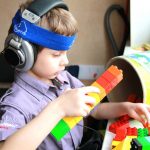In the previous blogs we covered the influence of the senses (auditory and visual), as well as timing on the development of reading. There is one more component to consider in order for us to decode the sound / symbol adequately and efficiently. Timing is one component of praxis (motor planning), though yet another component would be bilateral integration. Bilateral integration would be best described as the ability of the body to use the left and right side of the body in different functions at the same time. A good example would be the ability to hold the paper in one hand, turning it, as the other hand cuts the same paper. But there is more to consider.
At the most primitive level, the baby requires the assistance of the Asymmetrical Tonic Neck Reflex (ATNR) in order to move the body in a reflexive way. This reflex is developed in utero and assists in the birth process as the baby pushes head first to gain access to a world of light, sound, and movement. This reflex causes the baby to extend the upper and lower limb to the side the head was facing, while the opposite side of the body flexes. Turn the baby’s head and the opposite happens. This is the beginning of understanding laterality in the body. The development of the Symmetrical Tonic Neck Reflex (STNR) is also important as it assists the baby to move reflexively with upper and lower body. Essentially it is like a cat drinking milk. When the head goes down, the bottom goes up and when the bottom goes down, the head comes up. This is more evident during the baby’s first attempts to crawl and as the baby steadily gains control over crawling, this reflex would then become integrated.
When the baby starts rolling over from supine to prone position or from prone to supine position, they would require the upper body to be able to turn with clear segmentation through the trunk, separating the upper body from the lower body in a “turn” position. This would be the beginnings of integrating both the ATNR and STNR reflexes and also coincides with the baby’s ability to reach with his arms across midline of the body to grab hold of something.
The crawling action refines the integration of the ATNR and STNR and, over time, it steadily builds the ability to use effective bilateral integration. At first we see the same side upper and lower body complete similar actions, after which the body would then develop where upper and lower body in all 4 limbs could be acting in opposition of each other with fluidity and efficiency.
As bilateral integration ability in praxis grows in becoming more adept, the developing child starts developing an internal sense of left and right and we gain the earliest beginnings of establishing different dominance areas. Research does not support the specificity of a specific hand or foot dominance, but this innate sense of laterality becomes an important marker for school readiness in general. As the body develops this feature of laterality, it also supports the development of directionality. Directionality would be the ability to use the sense of laterality in space, such as planning ahead which direction to go or following multi-step directions to get from our office to a new store. As someone provides the directions our mind is able to follow the directions with the correct orientations of left and right in an automatic way.
It is at this level where we can really start using our eyes and hand easily from left to right and not be confused with this action during reading or writing. It is also here where developing efficiency in interhemispheric organization with specialization of reading occur in the left-brain. When we see reversals in both reading and writing, it is this interhemispheric organization that is not quite efficient as yet. And this specific organization is arranged in different systems, such as vision, auditory and the body and they all integrate together at this stage in order to create an efficient reader.
Haabib (2000) noted that there is a great overlap in cases of dyspraxia with dyslexia. The development described in this writing would be the essential overlap between these systems and it makes much sense when one considers the different components of development together with the different components of reading. In order to truly remediate decoding, it is never going to be sufficient to target one system at a time, or think that the student simply “needs more practice at a slower pace”. This type of intervention will only reinforce the difficulties that the student is already facing.
In our final blog on reading (for now), we will discuss the reading process and the impact of working memory (not long-term memory) for the act of reading.








